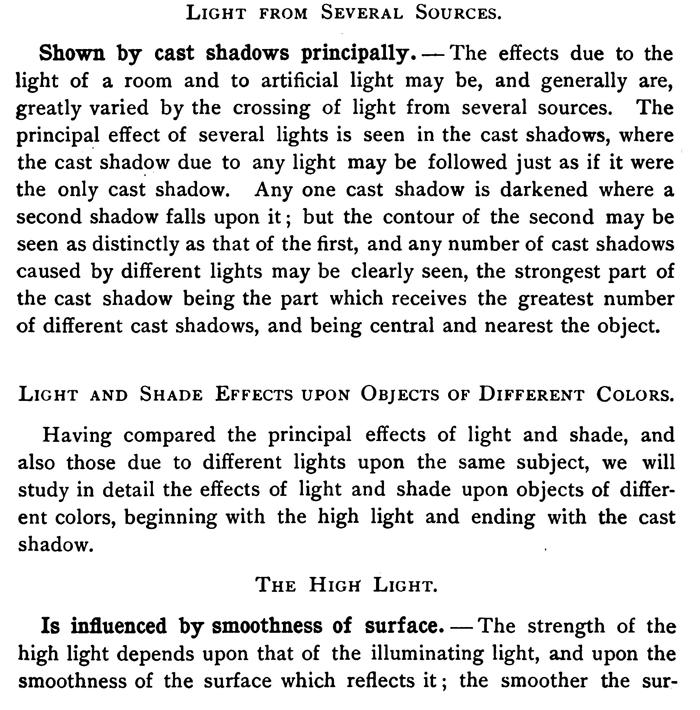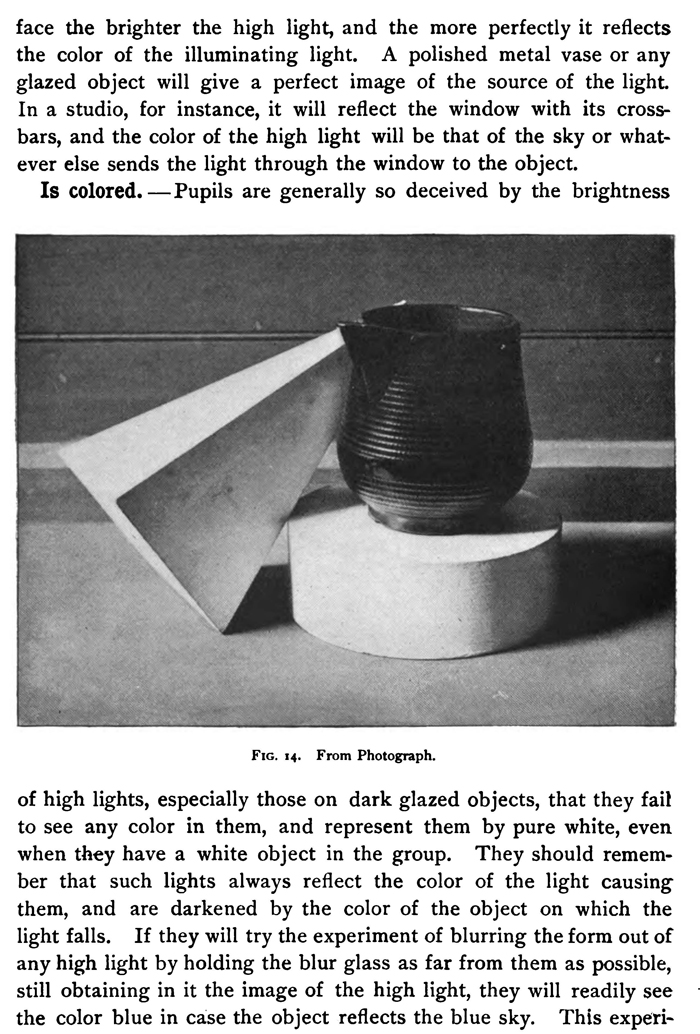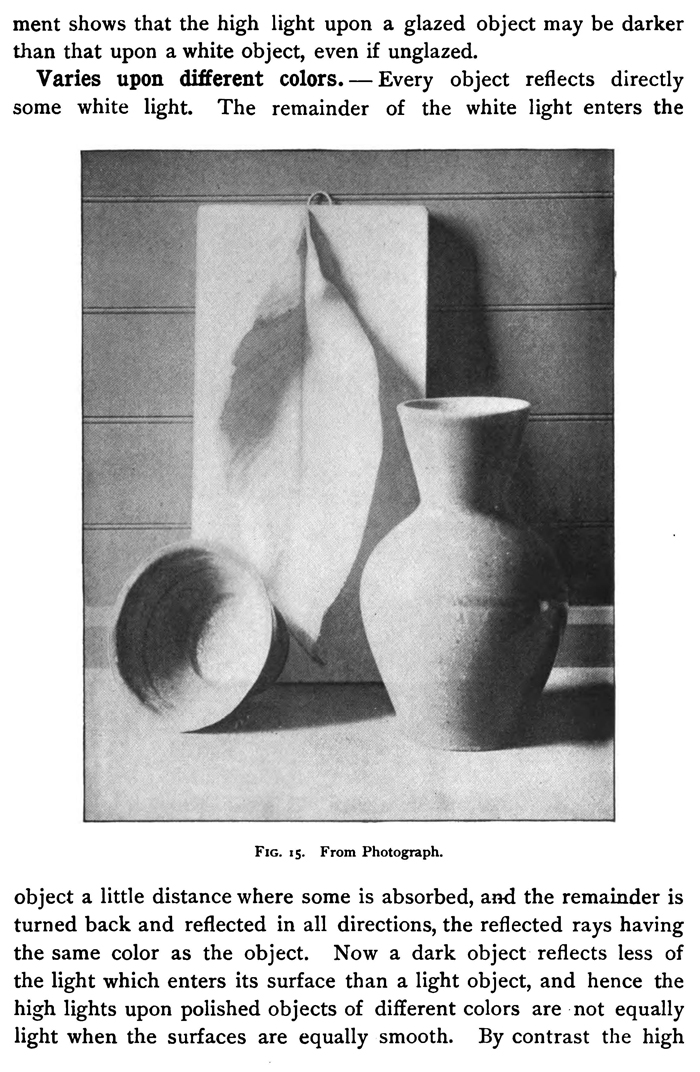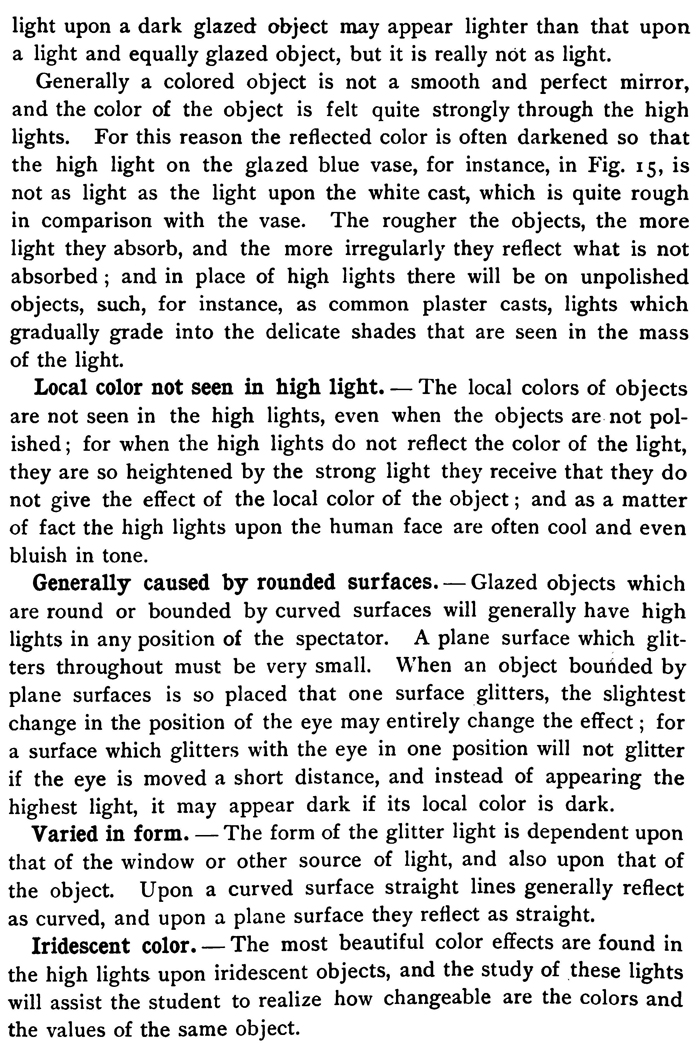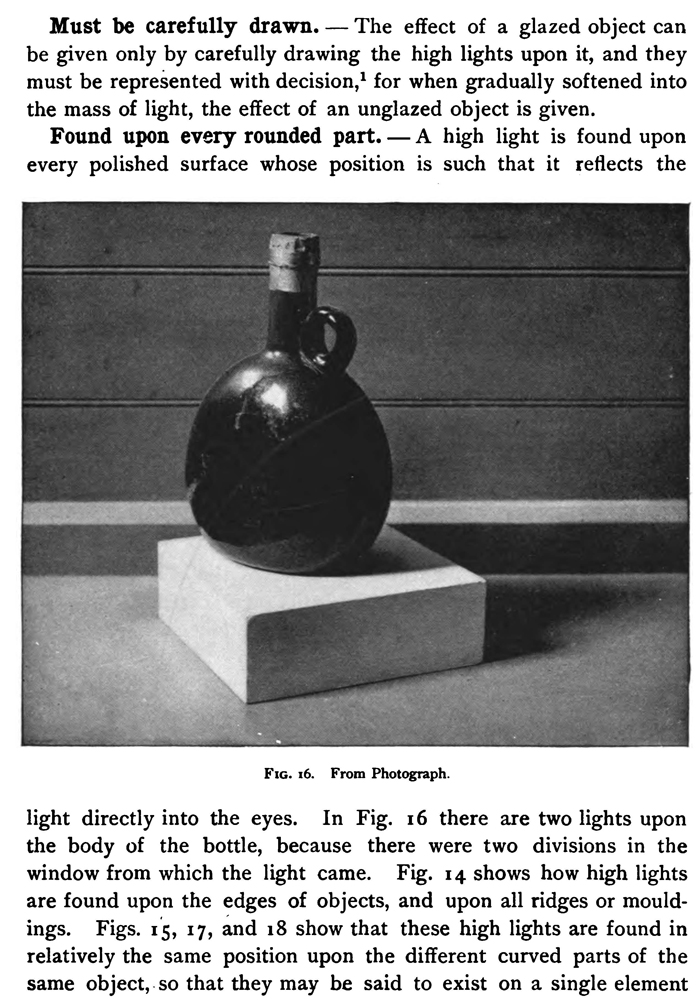Home > Directory of Drawing Lessons > How to Improve Your Drawings > Drawing Lights and Shadows > Drawing Object with Light Sources Coming From More Than One Spot
How to Draw & Shade Objects & Things with Multiple Light Sources Coming From All Side and Angles with the Following Drawing & Shading Lesson
|
|
LIGHT FROM SEVERAL SOURCES.Shown by cast shadows principally. The effects due to the light of a room and to artificial light may be, and generally are, greatly varied by the crossing of light from several sources. The principal effect of several lights is seen in the cast shadows, where the cast shadow due to any light may be followed just as if it were the only cast shadow. Any one cast shadow is darkened where a second shadow falls upon it ; but the contour of the second may be seen as distinctly as that of the first, and any number of cast shadows caused by different lights may be clearly seen, the strongest part of the cast shadow being the part which receives the greatest number of different cast shadows, and being central and nearest the object. LIGHT AND SHADE EFFECTS UPON OBJECTS OF DIFFERENT COLORS.Having compared the principal effects of light and shade, and also those due to different lights upon the same subject, we will study in detail the effects of light and shade upon objects of different colors, beginning with the high light and ending with the cast shadow. THE HIGH LIGHT.Is influenced by smoothness of surface.The strength of the high light depends upon that of the illuminating light, and upon the smoothness of the surface which reflects it ; the smoother the surface the brighter the high light, and the more perfectly it reflects the color of the illuminating light. A polished metal vase or any glazed object will give a perfect image of the source of the light. In a studio, for instance, it will reflect the window with its crossbars, and the color of the high light will be that of the sky or whatever else sends the light through the window to the object. Is colored.Pupils are generally so deceived by the brightness of high lights, especially those on dark glazed objects, that they fail to see any color in them, and represent them by pure white, even when they have a white object in the group. They should remember that such lights always reflect the color of the light causing them, and are darkened by the color of the object on which the light falls. If they will try the experiment of blurring the form out of any high light by holding the blur glass as far from them as possible, still obtaining in it the image of the high light, they will readily see the color blue in case the object reflects the blue sky. This experiment shows that the high light upon a glazed object may be darker than that upon a white object, even if unglazed. Varies upon different colors.Every object reflects directly some white light. The remainder of the white light enters the object a little distance where some is absorbed, and the remainder is turned back and reflected in all directions, the reflected rays having the same color as the object. Now a dark object reflects less of the light which enters its surface than a light object, and hence the high lights upon polished objects of different colors are not equally light when the surfaces are equally smooth. By contrast the high light upon a dark glazed object may appear lighter than that upon a light and equally glazed object, but it is really not as light. Generally a colored object is not a smooth and perfect mirror, and the color of the object is felt quite strongly through the high lights. For this reason the reflected color is often darkened so that the high light on the glazed blue vase, for instance, in Fig. 15, is not as light as the light upon the white cast, which is quite rough in comparison with the vase. The rougher the objects, the more light they absorb, and the more irregularly they reflect what is not absorbed ; and in place of high lights there will be on unpolished objects, such, for instance, as common plaster casts, lights which gradually grade into the delicate shades that are seen in the mass of the light. Local color not seen in high light.The local colors of objects are not seen in the high lights, even when the objects are not polished; for when the high lights do not reflect the color of the light, they are so heightened by the strong light they receive that they do not give the effect of the local color of the object ; and as a matter of fact the high lights upon the human face are often cool and even bluish in tone. Generally caused by rounded surfaces.Glazed objects which are round or bounded by curved surfaces will generally have high lights in any position of the spectator. A plane surface which glitters throughout must be very small. When an object bounded by plane surfaces is so placed that one surface glitters, the slightest change in the position of the eye may entirely change the effect ; for a surface which glitters with the eye in one position will not glitter if the eye is moved a short distance, and instead of appearing the highest light, it may appear dark if its local color is dark. Varied in form.The form of the glitter light is dependent upon that of the window or other source of light, and also upon that of the object. Upon a curved surface straight lines generally reflect as curved, and upon a plane surface they reflect as straight. Iridescent color.The most beautiful color effects are found in the high lights upon iridescent objects, and the study of these lights will assist the student to realize how changeable are the colors and the values of the same object. Must be carefully drawn.The effect of a glazed object can be given only by carefully drawing the high lights upon it, and they must be represented with decision,' for when gradually softened into the mass of light, the effect of an unglazed object is given. Found upon every rounded part.A high light is found upon every polished surface whose position is such that it reflects the light directly into the eyes. In Fig. 16 there are two lights upon the body of the bottle, because there were two divisions in the window from which the light came. Fig. 14 shows how high lights are found upon the edges of objects, and upon all ridges or mouldings. Figs. 15, 17, and 18 show that these high lights are found in relatively the same position upon the different curved parts of the same object, so that they may be said to exist on a single element of the surface. In the cone and cylinder the element is straight, but in the bottle or vase the corresponding line or element is curved, and may be regarded as the outline of a section of the object made by a plane passing through the axis ; it is foreshortened so that, in Fig. 18, for instance, if the light were directly behind the spectator, the different high lights upon the vase would come in one vertical line, — the center line of the vase. |
Privacy Policy ...... Contact Us





